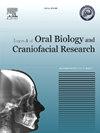微弧氧化和喷砂对骨水泥种植体修复体固位的比较评价:一项体外研究
Q1 Medicine
Journal of oral biology and craniofacial research
Pub Date : 2025-04-18
DOI:10.1016/j.jobcr.2025.04.004
引用次数: 0
摘要
材料和方法将 30 个种植体模拟体分别嵌入自聚合丙烯酸树脂块中,与 30 个钛种植体基台配对,并根据表面处理情况分为三组(每组 n = 10)。第一组包括未经处理的种植基台;第二组包括经过喷砂处理的基台;第三组包括经过微弧氧化处理的基台。使用扫描电子显微镜对基台表面进行定性分析。每个基台都与嵌入树脂块中的模拟基台相连。使用快速添加原型(3D 打印)制作树脂基台,然后将其浇铸成镍铬合金基台,并使用聚羧酸锌水门汀将其粘结在基台上。使用轴向扭转伺服液压疲劳测试系统对测试样品进行拉伸结合强度(TBS)测试。结果种植体基台上的水门汀平均 TBS 值为:I 组 4.276 MPa;II 组 6.340 MPa;III 组 8.117 MPa。经比较,III 组的平均 TBS 值最高,其次是 II 组,而 I 组的强度最低。表面定性分析显示,与第一组相比,第二组和第三组的测试样本表面粗糙度更大。结论与喷砂法相比,使用喷砂法和微弧氧化法对种植基台进行表面处理可提高水门汀铸造基台的拉伸粘结强度,而且 MAO 能显著提高水门汀固位修复体的固位力。本文章由计算机程序翻译,如有差异,请以英文原文为准。
Comparative evaluation of Microarc Oxidation and sandblasting on the retention of cement-retained implant restorations: An in-vitro study
Purpose
The aim was to compare the impact of two distinct surface treatment methods on implant abutments concerning the retention of implant-supported restorations.
Materials and methods
30 implant analogs, individually embedded into blocks of autopolymerizing acrylic resin, were paired with 30 titanium implant abutments and divided into three groups (each, n = 10) based on surface treatment. Group I included untreated implant abutments; group II included abutments treated with sandblasting; and group III comprised abutments treated with Microarc Oxidation. A qualitative surface analysis was conducted using scanning electron microscope. Each abutment was connected to its analog embedded in the resin block. Resin copings were fabricated using rapid additive prototyping (3D printing) and cast into Ni-Cr alloy copings and cemented onto the abutments using zinc-polycarboxylate cement. Test samples were subjected to tensile bond strength (TBS) testing using an Axial-Torsion Servohydraulic Fatigue-Testing System. The results were tabulated and subjected to statistical evaluation.
Results
The mean TBS of the cemented cast copings on implant abutments was 4.276 MPa-group I; 6.340 MPa-group II; and 8.117 MPa-group III. Upon comparison, group III demonstrated the highest mean TBS, followed by group II, while group I exhibited the lowest strength. Qualitative surface analysis revealed that the test samples in group II and group III had greater surface roughness compared to those in group I.
Conclusion
The surface treatments of implant abutments using sandblasting and Microarc Oxidation enhanced the tensile bond strength of cemented cast copings and, MAO significantly increased retention of cement-retained restorations compared to sandblasting.
求助全文
通过发布文献求助,成功后即可免费获取论文全文。
去求助
来源期刊

Journal of oral biology and craniofacial research
Medicine-Otorhinolaryngology
CiteScore
4.90
自引率
0.00%
发文量
133
审稿时长
167 days
期刊介绍:
Journal of Oral Biology and Craniofacial Research (JOBCR)is the official journal of the Craniofacial Research Foundation (CRF). The journal aims to provide a common platform for both clinical and translational research and to promote interdisciplinary sciences in craniofacial region. JOBCR publishes content that includes diseases, injuries and defects in the head, neck, face, jaws and the hard and soft tissues of the mouth and jaws and face region; diagnosis and medical management of diseases specific to the orofacial tissues and of oral manifestations of systemic diseases; studies on identifying populations at risk of oral disease or in need of specific care, and comparing regional, environmental, social, and access similarities and differences in dental care between populations; diseases of the mouth and related structures like salivary glands, temporomandibular joints, facial muscles and perioral skin; biomedical engineering, tissue engineering and stem cells. The journal publishes reviews, commentaries, peer-reviewed original research articles, short communication, and case reports.
 求助内容:
求助内容: 应助结果提醒方式:
应助结果提醒方式:


